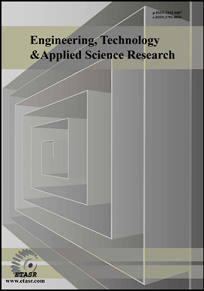Investigation of the Ιmpact of HVOF Spraying Parameters on the Abrasion Resistance of Tungsten Carbide Coatings
Received: 1 June 2024 | Revised: 18 July 2024 and 10 September 2024 | Accepted: 14 September 2024 | Online: 30 September 2024
Corresponding author: Hong Tien Nguyen
Abstract
For components operating under high pressure and high values of friction conditions, rapid wear is a common issue. Surface treatment measures are often employed to enhance the working lifespan of such components by improving their resistance to abrasion. This paper utilizes the Taguchi experimental design method in conjunction with Analysis of Variance (ANOVA) to assess the impact of spraying parameters on the abrasion resistance of the coating when applying the HVOF method. The sprayed material is WC HMSP1060-00+60% 4070, primarily consisting of Nickel and Tungsten Carbide, whereas the material for manufacturing the pressing screws is 1045 steel. The investigated spraying parameters include the spray Flow Rate (F), Spray Distance (D), and Oxygen/Propane Ratio (R). The experimental results are analyzed to determine the most suitable spraying parameters to achieve the highest abrasion resistance, and thereby improve the working lifespan of the components.
Keywords:
spraying parameters, friction, abrasion, HVOF method, working lifespanDownloads
References
M. J. Azizpour, S. Norouzi, and D. Sajedipour, “An Axisymmetrical Finite Element Model for Prediction of the Bonding Behavior in HVOF Thermal Spraying Coatings,” Journal of Applied Sciences, vol. 12, no. 5, pp. 492–497, Jun. 2012. DOI: https://doi.org/10.3923/jas.2012.492.497
H. K. Le, “A Study on the Influence of Plasma Nitriding Technology Parameters on the Working Surface Deformation of Hypoid Gears,” Engineering, Technology & Applied Science Research, vol. 12, no. 6, pp. 9760–9765, Dec. 2022. DOI: https://doi.org/10.48084/etasr.5365
L. Wu, X. Guo, and J. Zhang, “Abrasive Resistant Coatings—A Review,” Lubricants, vol. 2, no. 2, pp. 66–89, Jun. 2014. DOI: https://doi.org/10.3390/lubricants2020066
S. Thermsuk and P. Surin, “Abrasion wear of HVOF sprayed coatings on SUS 400 stainless steel,” International Journal of Applied Engineering Research, vol. 13, no. 20, pp. 14675–14678, 2018.
T.-L. Nguyen, H. T. Nguyen, V. T. Nguyen, and D. D. Khuat, “Analysis of the effect of spray mode on coating porosity and hardness when spraying press screws by the high velocity oxy fuel method,” EUREKA: Physics and Engineering, no. 6, pp. 93–103, Nov. 2023. DOI: https://doi.org/10.21303/2461-4262.2023.003161
J. E. Bringas, Handbook of Comparative World Steel Standards, Third Edition. USA: ASTM International, 2004.
J. R. Davis, Handbook of Thermal Spray Technology. ASM International, 2004.
L. Pawlowski, The Science and Engineering of Thermal Spray Coatings. John Wiley & Sons, 2008. DOI: https://doi.org/10.1002/9780470754085
R. K. Roy, Design of Experiments Using the Taguchi Approach, 16 Steps to Product and Process Improvement. Canada: John Wiley & Sons, Inc, 2001.
D. C. Montgomery, Design and Analysis of Experiments, 10e Enhanced eText with Abridged Print Companion. Wiley, 2019.
J. S. Arora, Introduction to Optimum Design. Elsevier, 2004. DOI: https://doi.org/10.1016/B978-012064155-0/50012-4
Downloads
How to Cite
License
Copyright (c) 2024 Hong Tien Nguyen, Tuan Linh Nguyen, Van Thien Nguyen, Long Hoang

This work is licensed under a Creative Commons Attribution 4.0 International License.
Authors who publish with this journal agree to the following terms:
- Authors retain the copyright and grant the journal the right of first publication with the work simultaneously licensed under a Creative Commons Attribution License that allows others to share the work with an acknowledgement of the work's authorship and initial publication in this journal.
- Authors are able to enter into separate, additional contractual arrangements for the non-exclusive distribution of the journal's published version of the work (e.g., post it to an institutional repository or publish it in a book), with an acknowledgement of its initial publication in this journal.
- Authors are permitted and encouraged to post their work online (e.g., in institutional repositories or on their website) after its publication in ETASR with an acknowledgement of its initial publication in this journal.

